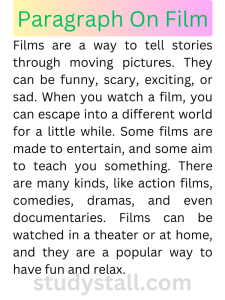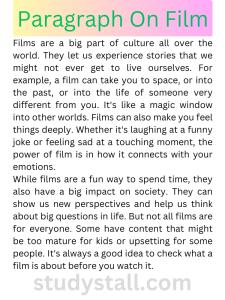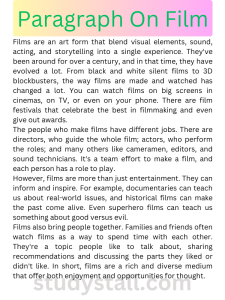Film has become an integral part of our modern society, captivating audiences around the world with its captivating stories, mesmerizing visuals, and powerful emotions. From the early days of silent films to the present era of blockbuster hits, the art of filmmaking has evolved and transformed, leaving a lasting impact on our lives. In this article, we will delve into the world of film, exploring its history, significance, and the various aspects that make it a unique and influential form of art and entertainment.
Paragraph On Film 100 words
Films are a way to tell stories through moving pictures. They can be funny, scary, exciting, or sad. When you watch a film, you can escape into a different world for a little while. Some films are made to entertain, and some aim to teach you something. There are many kinds, like action films, comedies, dramas, and even documentaries. Films can be watched in a theater or at home, and they are a popular way to have fun and relax.
Paragraph On Film 200 words
Films are a big part of culture all over the world. They let us experience stories that we might not ever get to live ourselves. For example, a film can take you to space, or into the past, or into the life of someone very different from you. It’s like a magic window into other worlds. Films can also make you feel things deeply. Whether it’s laughing at a funny joke or feeling sad at a touching moment, the power of film is in how it connects with your emotions.
While films are a fun way to spend time, they also have a big impact on society. They can show us new perspectives and help us think about big questions in life. But not all films are for everyone. Some have content that might be too mature for kids or upsetting for some people. It’s always a good idea to check what a film is about before you watch it.
Paragraph On Film 300 words
Films are an art form that blend visual elements, sound, acting, and storytelling into a single experience. They’ve been around for over a century, and in that time, they have evolved a lot. From black and white silent films to 3D blockbusters, the way films are made and watched has changed a lot. You can watch films on big screens in cinemas, on TV, or even on your phone. There are film festivals that celebrate the best in filmmaking and even give out awards.
The people who make films have different jobs. There are directors, who guide the whole film; actors, who perform the roles; and many others like cameramen, editors, and sound technicians. It’s a team effort to make a film, and each person has a role to play.
However, films are more than just entertainment. They can inform and inspire. For example, documentaries can teach us about real-world issues, and historical films can make the past come alive. Even superhero films can teach us something about good versus evil.
Films also bring people together. Families and friends often watch films as a way to spend time with each other. They’re a topic people like to talk about, sharing recommendations and discussing the parts they liked or didn’t like. In short, films are a rich and diverse medium that offer both enjoyment and opportunities for thought.
Paragraph On Film 500 words
Evolution of Film
The journey of film began in the late 19th century, with the invention of motion picture cameras. Revolutionary filmmakers like Lumière Brothers and Georges Méliès paved the way for the development of narrative storytelling through moving images. As technology advanced, the introduction of synchronized sound in the late 1920s brought a new dimension to the cinematic experience, giving birth to the era of “talkies.”
With time, film techniques and visual effects continued to evolve, allowing directors to explore new realms of creativity. The emergence of color films, special effects, and computer-generated imagery (CGI) pushed the boundaries of visual storytelling, transporting audiences into fantastical worlds and expanding the possibilities of storytelling.
Significance of Film
Film holds immense significance not only as a form of entertainment but also as a powerful medium for education, cultural expression, and social commentary. It has the ability to transport us to different time periods, cultures, and perspectives, fostering empathy and understanding. Here are some key reasons why film is significant:
- Storytelling: Films have the power to tell stories that resonate with people from all walks of life. Whether it’s a heartwarming romance, an edge-of-your-seat thriller, or a thought-provoking documentary, films have the ability to engage, inspire, and provoke emotions.
- Cultural Reflection: Films often reflect the cultural, social, and political climate of the time in which they were made. They provide a lens through which we can explore different societies, traditions, and perspectives, fostering cross-cultural understanding and appreciation.
- Entertainment: Film is a form of escapism, allowing us to temporarily immerse ourselves in captivating narratives and visually stunning worlds. It serves as a source of entertainment, providing a much-needed break from our daily routines.
- Education: Films can be educational tools, shedding light on historical events, important social issues, or scientific discoveries. Documentaries, in particular, have the power to raise awareness and create social change by presenting real-life stories and exposing hidden truths.
- Inspiration: Film has the ability to inspire and motivate individuals. Whether it’s through relatable characters, powerful dialogues, or memorable scenes, films can ignite a sense of passion, creativity, and aspiration within the audience.
Elements of Film
To create a compelling film, various elements come together, working in harmony to captivate the audience. These elements include:
1. Screenplay
The screenplay serves as the foundation of a film, outlining the story, characters, dialogue, and overall structure. It is the blueprint that guides the director, actors, and crew in bringing the story to life on the screen.
2. Cinematography
Cinematography refers to the art and technique of capturing images on film or digitally. It involves the composition, lighting, camera movement, and visual aesthetics that contribute to the overall mood and atmosphere of a film.
3. Acting
Acting is a crucial element that brings characters to life. Skilled actors use their talent, emotions, and physicality to portray the thoughts, feelings, and motivations of their characters, creating a connection with the audience.
4. Editing
Editing is the process of selecting, arranging, and manipulating footage to create a coherent and engaging narrative. It involves the careful coordination of shots, pacing, transitions, and visual effects to enhance the storytelling and evoke desired emotions.
5. Sound Design
Sound design encompasses all auditory elements in a film, including dialogue, music, sound effects, and ambient noises. It enhances the overall cinematic experience by creating a realistic and immersive environment.
The Future of Film
As technology continues to advance at a rapid pace, the future of film holds endless possibilities. Virtual reality (VR), augmented reality (AR), and interactive storytelling are already transforming the way we engage with films, allowing viewers to become active participants in the narrative.
Furthermore, the rise of streaming platforms and online distribution has democratized the filmmaking process, making it more accessible for independent filmmakers to showcase their work to a global audience.
In conclusion, film is a powerful art form that has the ability to transport, entertain, educate, and inspire. Its evolution over the years has shaped our cultural landscape and continues to captivate audiences worldwide. Whether it’s through the magic of storytelling, the visual spectacle, or the emotional depth of performances, film has the power to leave a lasting impact on our lives. So, grab some popcorn, sit back, and immerse yourself in the enchanting world of film.
FAQ
Q: What is the significance of film?
A: Film is significant as it is a powerful medium for education, cultural expression, and social commentary. It has the ability to transport us to different time periods, cultures, and perspectives, fostering empathy and understanding.
Q: How has film evolved over time?
A: Film has evolved from the invention of motion picture cameras in the late 19th century to the introduction of synchronized sound in the late 1920s. It has continued to advance with the emergence of color films, special effects, and computer-generated imagery (CGI), pushing the boundaries of visual storytelling.
Q: How does film reflect culture?
A: Films often reflect the cultural, social, and political climate of the time in which they were made. They provide a lens through which we can explore different societies, traditions, and perspectives, fostering cross-cultural understanding and appreciation.
Q: What is the power of storytelling in film?
A: Films have the power to tell stories that resonate with people from all walks of life. Whether it’s a heartwarming romance, an edge-of-your-seat thriller, or a thought-provoking documentary, films have the ability to engage, inspire, and provoke emotions.




